过去完成时语法
九年级英语语法:过去完成时
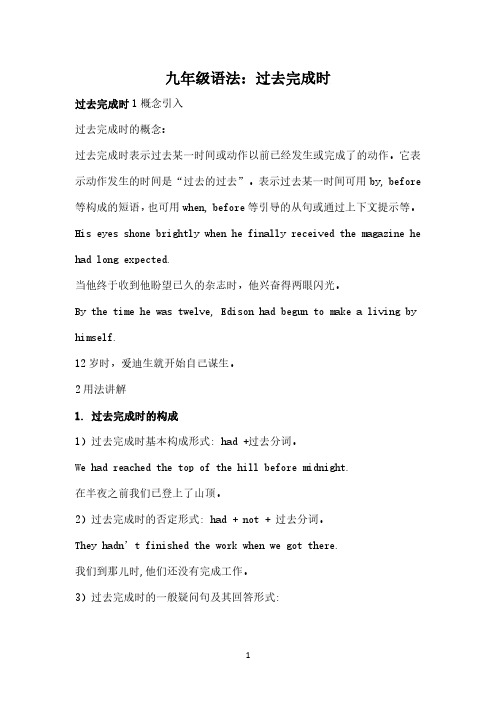
九年级语法:过去完成时过去完成时1概念引入过去完成时的概念:过去完成时表示过去某一时间或动作以前已经发生或完成了的动作。
它表示动作发生的时间是“过去的过去”。
表示过去某一时间可用by, before 等构成的短语,也可用when, before等引导的从句或通过上下文提示等。
His eyes shone brightly when he finally received the magazine he had long expected.当他终于收到他盼望已久的杂志时,他兴奋得两眼闪光。
By the time he was twelve, Edison had begun to make a living by himself.12岁时,爱迪生就开始自己谋生。
2用法讲解1. 过去完成时的构成1)过去完成时基本构成形式: had +过去分词。
We had reached the top of the hill before midnight.在半夜之前我们已登上了山顶。
2)过去完成时的否定形式: had + not + 过去分词。
They hadn’t finished the work when we got there.我们到那儿时,他们还没有完成工作。
3)过去完成时的一般疑问句及其回答形式:疑问句要把had提到句首;回答用Yes, 主语+ had. / No, 主语+ hadn’t.—Had he told you to go there earlier yesterday? 他昨天告诉过你早点儿到那儿吗?—Yes, he had. (No, he hadn’t.) 是的,他告诉了。
(不,他没有。
) 注意:had not 常简略为hadn't。
2. 过去完成时的用法过去完成时的主要用法和现在完成时一样。
不同的是,过去完成时把时间推移到了过去某一时间之前,与现在无关。
1)过去完成时表示在过去某一时间或动作以前已经完成了的动作。
过去完成时(past perfect)
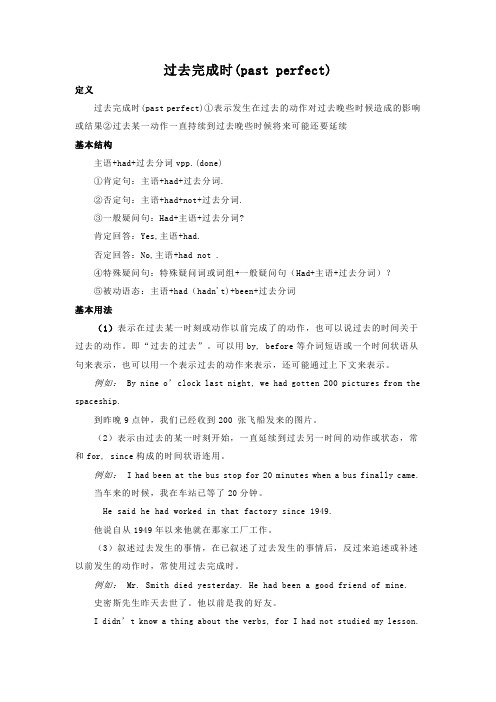
过去完成时(past perfect)定义过去完成时(past perfect)①表示发生在过去的动作对过去晚些时候造成的影响或结果②过去某一动作一直持续到过去晚些时候将来可能还要延续基本结构主语+had+过去分词vpp.(done)①肯定句:主语+had+过去分词.②否定句:主语+had+not+过去分词.③一般疑问句:Had+主语+过去分词?肯定回答:Yes,主语+had.否定回答:No,主语+had not .④特殊疑问句:特殊疑问词或词组+一般疑问句(Had+主语+过去分词)?⑤被动语态:主语+had(hadn't)+been+过去分词基本用法(1)表示在过去某一时刻或动作以前完成了的动作,也可以说过去的时间关于过去的动作。
即“过去的过去”。
可以用by, before等介词短语或一个时间状语从句来表示,也可以用一个表示过去的动作来表示,还可能通过上下文来表示。
例如:By nine o’clock last night, we had gotten 200 pictures from the spaceship.到昨晚9点钟,我们已经收到200 张飞船发来的图片。
(2)表示由过去的某一时刻开始,一直延续到过去另一时间的动作或状态,常和for, since构成的时间状语连用。
例如:I had been at the bus stop for 20 minutes when a bus finally came.当车来的时候,我在车站已等了20分钟。
He said he had worked in that factory since 1949.他说自从1949年以来他就在那家工厂工作。
(3)叙述过去发生的事情,在已叙述了过去发生的事情后,反过来追述或补述以前发生的动作时,常使用过去完成时。
例如:Mr. Smith died yesterday. He had been a good friend of mine.史密斯先生昨天去世了。
动词时态过去完成时的用法

动词时态过去完成时的用法动词时态在英语语法中扮演着重要的角色,它用于准确描述一个动作或状态是发生在过去、现在还是将来。
过去完成时是过去时态中的一种,用来表示在过去某一时间或事件之前已经发生的动作或状态。
本文将详细介绍过去完成时的用法及相关例句。
一、过去完成时的结构与构成:过去完成时的结构由助动词“had”加上过去分词构成。
例如:“had + 过去分词”。
二、过去完成时的用法:1. 表示过去某一时间或事件之前已经完成的动作或状态:过去完成时用于描述在过去某个时间点、事件或动作之前已经完成的另一个过去动作或状态。
此时,通常与表示过去的时间状语连用,如:by the time, before, when等。
例句1:By the time I arrived, she had already left.(在我到达时,她已经离开了。
)例句2:He had finished his homework before he went to bed.(他睡觉之前已经完成了作业。
)2. 表示过去直到某一时间已经发生或已经完成的动作或状态:过去完成时还可用于表示过去某一时间一直延续到另一过去时间之前已经发生或完成的动作或状态。
例句1:She had lived in New York for three years before she moved to London.(在她搬到伦敦之前,她在纽约已经住了三年。
)例句2:They had known each other since they were children.(他们从小就认识彼此。
)3. 与过去某一时间的比较:过去完成时可用于与过去某一时间进行比较,表示在过去某一时间之前已经完成的动作或状态。
例句1:John had already left when I arrived home.(我到家的时候,约翰已经离开了。
)例句2:She had finished her presentation by the time the meeting started.(会议开始时,她已经完成了演讲。
过去完成时
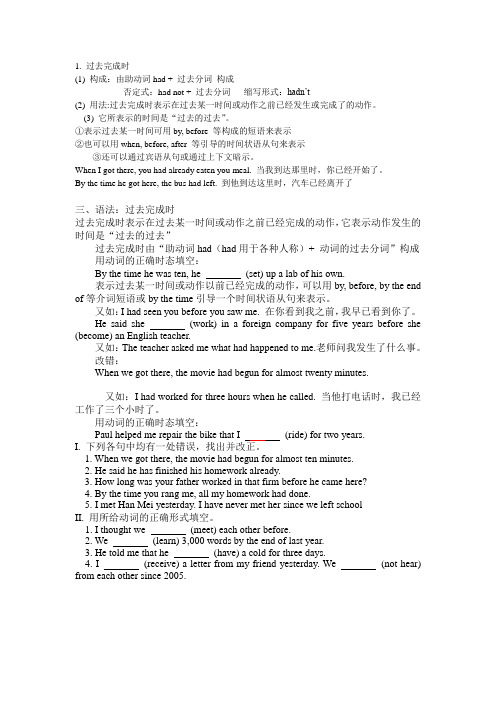
1. 过去完成时(1) 构成:由助动词had + 过去分词构成否定式:had not + 过去分词缩写形式:hadn’t(2) 用法:过去完成时表示在过去某一时间或动作之前已经发生或完成了的动作。
(3) 它所表示的时间是“过去的过去”。
①表示过去某一时间可用by, before 等构成的短语来表示②也可以用when, before, after 等引导的时间状语从句来表示③还可以通过宾语从句或通过上下文暗示。
When I got there, you had already eaten you meal. 当我到达那里时,你已经开始了。
By the time he got here, the bus had left. 到他到达这里时,汽车已经离开了三、语法:过去完成时过去完成时表示在过去某一时间或动作之前已经完成的动作,它表示动作发生的时间是“过去的过去”过去完成时由“助动词had(had用于各种人称)+ 动词的过去分词”构成用动词的正确时态填空:By the time he was ten, he (set) up a lab of his own.表示过去某一时间或动作以前已经完成的动作,可以用by, before, by the end of等介词短语或by the time引导一个时间状语从句来表示。
又如:I had seen you before you saw me. 在你看到我之前,我早已看到你了。
He said she (work) in a foreign company for five years before she (become) an English teacher.又如:The teacher asked me what had happened to me.老师问我发生了什么事。
改错:When we got there, the movie had begun for almost twenty minutes.又如:I had worked for three hours when he called. 当他打电话时,我已经工作了三个小时了。
过去完成时-英语语法课件

过去完成时的疑问句 一般疑问句句型:Had + 主语 + 过去分词...? 回答方式: Yes,主语 + had. / No,主语 + had + not.
过去完成时的疑问句是将助动词had置于主语之前(大写had的第一个字母),在句尾 加问号;这种语序是倒装语序:
I visited the museum yesterday. —Had you visited it before? —Yes,I had./No,I hadn’t. 昨天我参观了这个博物馆。 ——你以前参观过这个博物馆吗? ——是,我去过。/没有,我以前没有去过。
过去完成时的肯定句 句型:主语 + had + 过去分词...
过去完成时的肯定句由助动词had加过去分词构成:
He had already been to New York earlier in the week. 本周早些时候他去过纽约。 Jane had just left when you rang. 你打电话时简刚走。
这 时从句的动作和主句的动作发生的先后顺序已经非常明确,这时可以用一般过去时代替过去完成时。 例句: After he arrived in England, Marx worked hard to improve his English. 马克思到达英格兰之后,努力提高他的英语水平。
动词think, want, hope, mean, plan, intend等用过去完成时来表示过去未曾实现 的想法,希望,打算或意图等。
( 3 ) before + 过去的时间点。如: They had planted six hundred trees before last Wednesday. 在上星期三之前,他们已经种了六百棵树了。
初中英语语法——过去完成时

初中英语语法——过去完成时过去完成时表示在过去某一时间或动作之前已经完成的动作或存在的状态。
过去完成时是一种相对状态,情调动作发生的时间是“过去的过去”。
1.过去完成时谓语动词的结构形式过去完成时谓语动词的结构形式为:助动词had+过去分词。
had在句中没有人称和数的变化。
如:My father had left before I came here.My parents had begun to work by the time I got up.2.过去完成时的用法(1)表示在过去某时刻或在过去另一动作之前所完成的动作,即“过去的过去”。
如:She had learned English before she came to English.I asked him if he had ever seen a whale blowing.(2)表示过去某一时间以前开始一直延续到那个时间并可能继续下去的动作或状态,常与for 或since引导的表示时间的短语或从句连用。
如:He had studied English for five years when he went to the middle school.He had been ill for a week when he was sent to the hospital.(3)过去完成时还经常用于主句为过去时的宾语从句中。
在宾语从句中,主句用了一般过去时,从句表示完成用过去完成时。
如:He said he had been a soldier.They said they had seen the film.(4)表示过去未曾实现的希望或计划用过去完成时。
如:I had hoped to pass the examination.(可是未通过)She had thought of paying us a visit,but the bad weather made her change her plan.3.过去完成时与一般过去时的区别一般过去时和过去完成时都表示动作发生在过去。
初中英语过去完成时及详细讲解

初中英语语法及过去完成时详解过去完成时是英语中一种表示过去某一时间点之前已经发生的动作或情况的时态。
它由"had + 过去分词"构成。
过去完成时的用法如下:1. 表示在过去某一时间点之前已经完成的动作:①She had already finished her homework when I arrived.(我到达时,她已经完成了作业。
)这里表示在我到达之前,她已经完成了作业。
②They had left before the concert started.(音乐会开始之前,他们已经离开了。
)这里表示在音乐会开始之前,他们已经离开了。
2. 表示在过去某一时间点之前持续的动作或状态:①He had been studying English for three years before he moved to England.(在他搬去英国之前,他已经学习英语三年了。
)这里表示在他搬去英国之前,他一直在学习英语。
需要注意的是,过去完成时强调的是过去某一时间点之前的动作或情况。
因此,常与过去的时间状语连用,如before、after等,以明确指定过去的时间点。
另外,过去完成时常与过去简单时连用,用于表示两个过去的动作或情况的先后顺序。
过去完成时的动作通常发生在过去简单时的动作之前。
例如:①She had finished her homework before she went to bed.(她在睡觉前已经完成了作业。
)②They had already left when I arrived at the party.(当我到达派对时,他们已经离开了。
)总结起来,过去完成时用于表示过去某一时间点之前已经发生的动作或情况,常与过去的时间状语连用,以明确指定过去的时间点。
同时,过去完成时通常与过去简单时连用,以表示两个过去的动作或情况的先后关系。
英语语法之过去完成时

b. 用when ,before, after 等引导的时间状语从句。 The train had started before we got to the station. The plane had taken off when I reached the airport.
2. 过去完成时还可以表示过去某一时间以前发 生开始的动作持续到这一过去的时间。常与 for, since引导的表示一段时间的短语或从句 连用。如: I had worked in a hospital for three years before I came here. He told us that he had worked here since 10 years before.
过去完成时
过去完成时表示在过去某一时刻或某一动 作之前已经发生的动作或情况,即:过去 的过去。构成: ha成时表示在过去某一时间之前已经 完成的动作,表示对这一过去时间造成的 结果或影响。常用以下几种方式: a. 用by, before 等构成的介词短语。如: Linda had learnt 10 English songs by the end of last month. John had repaired that machine before midnight.
中考英语考点梳理:过去完成时语法详解!

一. 过去完成时的概念与结构概念:表示在过去某一时间或动作之前已经发生或完成了的动作,即“过去的过去( past-in-the-past )”。
构成:“助动词 had + 过去分词”,其中 had 通用于各种人称。
They had already had breakfast before they arrived at the hotel.在到达旅馆之前,他们已经吃过了早饭。
She had finished writing the composition by 10:00 this morning. 今天早晨10点之前,她已经写完了作文。
二. 过去完成时的用法用法 1.表示一个动作或状态在过去某一时间或动作之前已经完成或结束,即发生在“过去的过去”。
例如:When I woke up, it had stopped raining.我醒来时,雨已经停了。
(雨停发生在醒来之前,即“过去的过去”)用法2. 表示某一动作或状态在过去某时之前已经开始,一直延续到这一过去时间,而且动作尚未结束,仍然有继续下去的可能。
例如:By the end of last year, he had worked in the factory for twenty years. 到去年年底为止,他已经在这个工厂工作了20年。
(到去年年底为止已工作了 20 年,还有继续进行下去的可能)三. 过去完成时的判断依据1. 由时间状语来判定一般说来,各种时态都有特定的时间状语。
与过去完成时连用的时间状语有:(1)by + 过去的时间点,例如:I had finished reading the novel by nine o'clock last night.到昨天晚上九点钟为止,我已经读完了这本小说。
(2)by the end of + 过去的时间点,例如:We had learned over two thousand English words by the end of last term.到上学期末为止,我们已经学了两千多单词。
关于英语语法中的过去完成时

关于英语语法中的过去完成时一、什么叫过去完成时它是怎样构成的过去完成时表示一个动作或状态在过去某一时间或动作之前已经完成或结束,也可能是早已完成或结束,即过去的过去;也可以指过去的动作延续到过去的某个时刻。
过去完成时由had1 +动词的过去分词构成,had通常用于任何人称。
二、过去完成时有哪些用法过去完成时主要有以下几点用法:1. 表示过去某一时间或动作之前已经发生或完成的动作或存在的状态。
句中常用by,before,ost7 an hour. 当杰克到时,他得知玛丽已经离开快一个小时了。
3. 用于并列句:一个并列句用的是过去式,如果另一个并列句表示的动作早于过去式这一动作,这时需用过去完成时。
例如:Tom flee, but his father had already9 died10.汤姆乘飞机回家,他的父亲却已经去世了。
4. 某些动词的过去完成时表示过去未实现的希望、计划或打算。
常用的动词有hope11,expect12,suppose13,think,eprove20 his English.(3) 用在含有before的主从复合句中用在含有before的主从复合句中,一般在从句中使用一般过去时,主句中使用过去完成时。
例如:Lily21 had e letters before she e before the film ended.电影尚未放完,许多人就起身回家了。
(4) 用在含有oney had been used23 up, Peter had to turn to a friend for help. 当他的钱全都用光时,彼得只好转而求助于一个朋友。
有时,主句和从句的谓语动词的先后关系十分明确,两个动作紧接着发生,前一动作导致后一动作,这时两者均用一般过去时即可。
例如:When the meeting24 , turned on the light and found26 everything stolen27.I lost my pen but soon found it.She lost her pen, so I lent28 her mine.但是,如果两个先后发生的动作不是按时间的顺序排列或叙述时,为明确动作发生的先后顺序,先发生的动作就得用过去完成时。
过去完成时用法
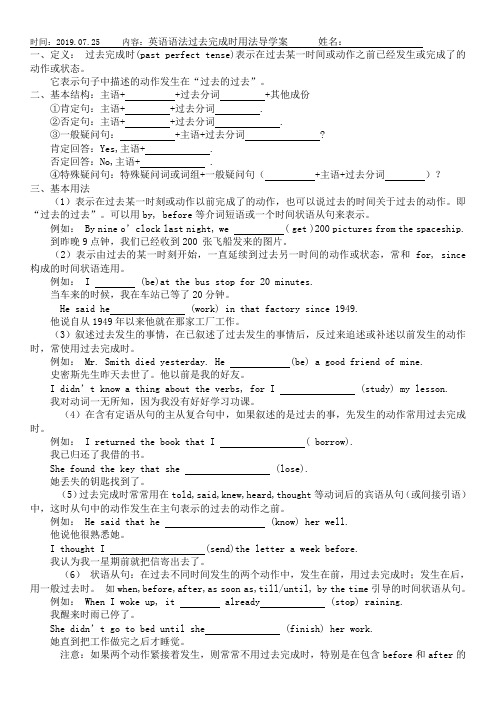
一、定义:过去完成时(past perfect tense)表示在过去某一时间或动作之前已经发生或完成了的动作或状态。
它表示句子中描述的动作发生在“过去的过去”。
二、基本结构:主语+ +过去分词 +其他成份①肯定句:主语+ +过去分词 .②否定句:主语+ +过去分词 .③一般疑问句: +主语+过去分词 ?肯定回答:Yes,主语+ .否定回答:No,主语+ .④特殊疑问句:特殊疑问词或词组+一般疑问句( +主语+过去分词)?三、基本用法(1)表示在过去某一时刻或动作以前完成了的动作,也可以说过去的时间关于过去的动作。
即“过去的过去”。
可以用by, before等介词短语或一个时间状语从句来表示。
例如:By nine o’clock last night, we ( get )200 pictures from the spaceship.到昨晚9点钟,我们已经收到200 张飞船发来的图片。
(2)表示由过去的某一时刻开始,一直延续到过去另一时间的动作或状态,常和 for, since 构成的时间状语连用。
例如: I (be)at the bus stop for 20 minutes.当车来的时候,我在车站已等了20分钟。
He said he (work) in that factory since 1949.他说自从1949年以来他就在那家工厂工作。
(3)叙述过去发生的事情,在已叙述了过去发生的事情后,反过来追述或补述以前发生的动作时,常使用过去完成时。
例如: Mr. Smith died yesterday. He (be) a good friend of mine.史密斯先生昨天去世了。
他以前是我的好友。
I didn’t know a thing about the verbs, for I (study) my lesson.我对动词一无所知,因为我没有好好学习功课。
(4)在含有定语从句的主从复合句中,如果叙述的是过去的事,先发生的动作常用过去完成时。
语法部分(七)过去完成时态
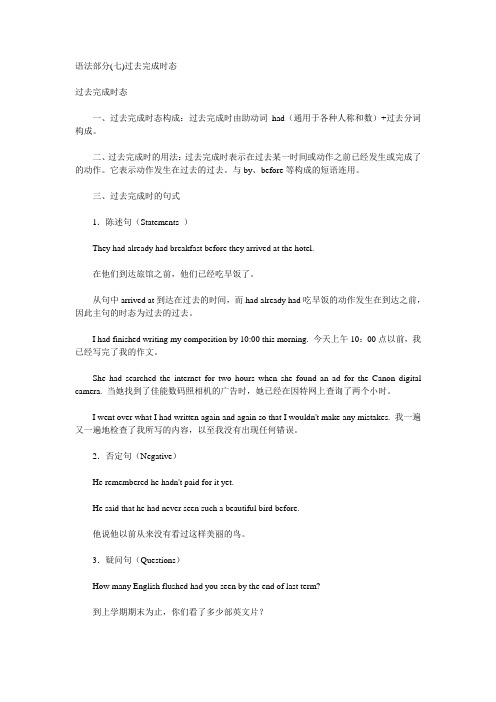
语法部分(七)过去完成时态过去完成时态一、过去完成时态构成:过去完成时由助动词had(通用于各种人称和数)+过去分词构成。
二、过去完成时的用法:过去完成时表示在过去某一时间或动作之前已经发生或完成了的动作。
它表示动作发生在过去的过去。
与by、before等构成的短语连用。
三、过去完成时的句式1.陈述句(Statements )They had already had breakfast before they arrived at the hotel.在他们到达旅馆之前,他们已经吃早饭了。
从句中arrived at到达在过去的时间,而had already had吃早饭的动作发生在到达之前,因此主句的时态为过去的过去。
I had finished writing my composition by 10:00 this morning. 今天上午10:00点以前,我已经写完了我的作文。
She had searched the internet for two hours when she found an ad for the Canon digital camera. 当她找到了佳能数码照相机的广告时,她已经在因特网上查询了两个小时。
I went over what I had written again and again so that I wouldn't make any mistakes. 我一遍又一遍地检查了我所写的内容,以至我没有出现任何错误。
2.否定句(Negative)He remembered he hadn't paid for it yet.He said that he had never seen such a beautiful bird before.他说他以前从来没有看过这样美丽的鸟。
3.疑问句(Questions)How many English flushed had you seen by the end of last term?到上学期期末为止,你们看了多少部英文片?Had you reached the station before ten o'clock?到十点以前,你们已经到达火车站了吗?四、过去完成时的构成过去完成时由助动词had (通用于各种人称和数)+过去分词构成。
语法精讲---过去完成时
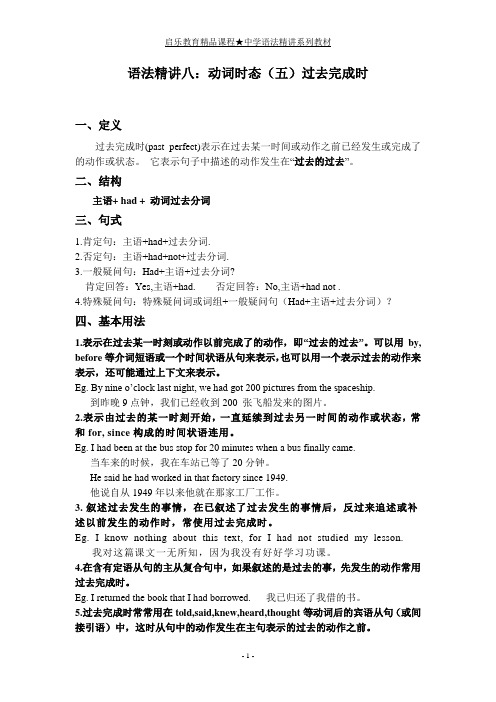
语法精讲八:动词时态(五)过去完成时一、定义过去完成时(past perfect)表示在过去某一时间或动作之前已经发生或完成了的动作或状态。
它表示句子中描述的动作发生在“过去的过去”。
二、结构主语+ had + 动词过去分词三、句式1.肯定句:主语+had+过去分词.2.否定句:主语+had+not+过去分词.3.一般疑问句:Had+主语+过去分词?肯定回答:Yes,主语+had. 否定回答:No,主语+had not .4.特殊疑问句:特殊疑问词或词组+一般疑问句(Had+主语+过去分词)?四、基本用法1.表示在过去某一时刻或动作以前完成了的动作,即“过去的过去”。
可以用by, before等介词短语或一个时间状语从句来表示,也可以用一个表示过去的动作来表示,还可能通过上下文来表示。
Eg. By nine o’clock last night, we had got 200 pictures from the spaceship.到昨晚9点钟,我们已经收到200 张飞船发来的图片。
2.表示由过去的某一时刻开始,一直延续到过去另一时间的动作或状态,常和for, since构成的时间状语连用。
Eg. I had been at the bus stop for 20 minutes when a bus finally came.当车来的时候,我在车站已等了20分钟。
He said he had worked in that factory since 1949.他说自从1949年以来他就在那家工厂工作。
3.叙述过去发生的事情,在已叙述了过去发生的事情后,反过来追述或补述以前发生的动作时,常使用过去完成时。
Eg. I know nothing about this text, for I had not studied my lesson.我对这篇课文一无所知,因为我没有好好学习功课。
4.在含有定语从句的主从复合句中,如果叙述的是过去的事,先发生的动作常用过去完成时。
关于过去完成时的语法

关于过去完成时的语法一、什么是过去完成时过去完成时(Past Perfect)是英语中的一种时态,表示在过去某个时间点或动作发生之前已经完成的动作或状态。
它通常由had + 过去分词构成。
二、过去完成时的构成1. 肯定句:主语 + had + 过去分词例如:I had finished my homework before my mother came back.2. 否定句:主语 + had not + 过去分词例如:I had not finished my homework before my mother came back.3. 疑问句:Had + 主语 + 过去分词?例如:Had you finished your homework before your mother came back?三、过去完成时的用法1. 表示在过去某个时间点或动作发生之前已经完成的动作或状态。
例如:I had studied English for three years before I went to America.2. 表示对于已经发生的事情,我们可以通过使用过去完成时来说明它们之间的先后顺序。
例如:He had already eaten breakfast when I arrived at his house.3. 用于讲述故事中先后发生的事件,以便更清晰地描述它们之间的关系。
例如:When I got home, I found that someone had broken into my house and stolen my TV.4. 可以与其他时间状语连用,如by the time, until等等,以表示在这些时间点之前已经完成了某个动作或状态。
例如:By the time I arrived at the party, everyone had already left.四、过去完成时的注意事项1. 过去完成时只能用于过去的时间,不能用于现在或将来。
高中英语语法过去完成时专题讲解

高中英语语法过去完成时专题讲解(一)过去完成时1.过去完成时:✈1).概念:过去发生或已经完成的动作对现在造成的影响或结果,或从过去已经开始,持续到现在的动作或状态。
✈2).时间状语:recently, lately, since…for…,in the past few years, etc.✈3).基本结构:have/has + done✈4).否定形式:have/has + not +done.✈5).一般疑问句:have或has提前概念:过去完成时表示在过去某一时间或动作之前已经发生或完成了的动作,即过去的过去(past-in-the-past ) ----|-------------------------- |-------------------------------|----------------------------> 那时以前 那时 现在 构成:过去完成时由"助动词had + 过去分词"构成,其中had 通用于各种人称。
They had already had breakfast before they arrived at the hotel.She had finished writing the composition by 10 :00 this morning.2、过去完成时的判断依据:由时间状语来判定✈ 1 )by + 过去的时间点。
Eg: I had finished reading the novel by nine o'clock last night.✈ 2 )by the end of + 过去的时间点。
Eg: We had learned over two thousand English words by the end of last term.✈ 3 )before + 过去的时间点。
Eg: They had planted six hundred trees before last Wednesday.3.课堂练习:一.用动词的适当形式填空1. We _____________ (paint) the house before we ______________ (move) in.2. That rich old man _____________ (make) a will before he _____________ (die).3. They _____________ (study) the map of the country before they ________ (leave).4. The robbers _____________ (run away ) before the policemen_______ (arrive).5. I __________ (turn off) all the lights before I ____________ (go) to bed.6. Paul __________ (go) out with Jane after he __________ (make) a phone call.7. Tom __________ (say) he ___________ (read) the book twice.8. Our plan ____________ (fail ) because we _____________ (make) a bad mistake.9. When the chairman ______________ (finish) speaking, he _____________ (leave)the hall.10.The Reads __ ______ (have) lunch when I ________________(get) to their house.二.句型转换1.I had sold the ticket when she came.(改否定句)2.She had sung a song to us before she danced.(改否定句)3.They began to climb the mountain after they had bought all the food and drinks.(否定)4.By 10:00 a.m, I had been very hungry. (改一般疑问)5.Lucy had already completed the project when I arrived.(改一般疑问)6.By the time he got to the airport, the plane had taken off. (改一般疑问)7..He had broken his arm when I saw him.(对划线部分提问)8.When he had read the note, he ate it. (对划线部分提问)9..Jack didn’t go to the cinema because he had seen the film. (对划线部分提问)10.We had had the toys for ten years before we gave them to the child. (对划线部分提问)Keys:一、1. had painted... moved 2. had made ... died 3. had studied…left4. had run away..arrived5. had turned off …went 6. went …had made 7. said …had read 8 failed …had made9. (had) finished …left 10. were having/had had …got二、1.I hadn't sold the ticket when she came.2. She hadn't sung a song to us before she danced.3. They didn't begin to climb the mountain after they had bought all the food and drinks.4. Had you been very hungry by 10:00 a.m?5. Had Lucy completed the project when I arrived yet?6. Had the plane taken off by the time he got to the airport?7. What had he done when you saw him?8.What did he do when he had read the note?9. Why didn't Jack go to the cinema?10. How long had you/we had the toys before you/we gave them to the child?(二)过去将来时:定义:它表示从过去某一时间来看将要发生的某个动作或存在的某种状态。
初中英语语法--过去完成时
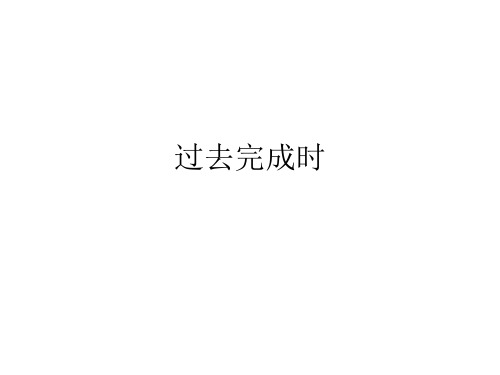
(2) “未完成”用法
• 表示一个动作在过去某一时间以前就已开 始,一直延续到另一个过去的时间,并有 可能继续下去。
• e.g. He had worked in this school for five years before he moved here.
• 搬到这里以前,他已经在那所学校工作了5 年了。
ห้องสมุดไป่ตู้
2、常与过去完成时连用的时间状语
• by yesterday 到昨天为止 • by the end of last week 到上周为止 • by the time... 到...时为止 • for+一段时间 • since+过去的某一个时间
3、构成
• 助动词had+动词的过去分词
句型转换
• 原句:They had worked for more than 12 hours, by the time of 6 o'clock.
• 否定句: • They hadn't worked.... • 疑问句: • Had they worked ... ? • 肯定回答: Yes, they had. • 否定回答: No, they hadn't.
过去完成时
1、用法
• (1) “已完成”用法 • 表示一个动作在过去某一时间或某一动作
之前已完成。 • e.g. By the time I was five, I had learnt 600
English words. • 我到5岁时,已经学了600个英语单词。
• 在宾语从句中,也经常使用过去完成时, 表示从句动作先于主句动作发生。
语法过去完成时
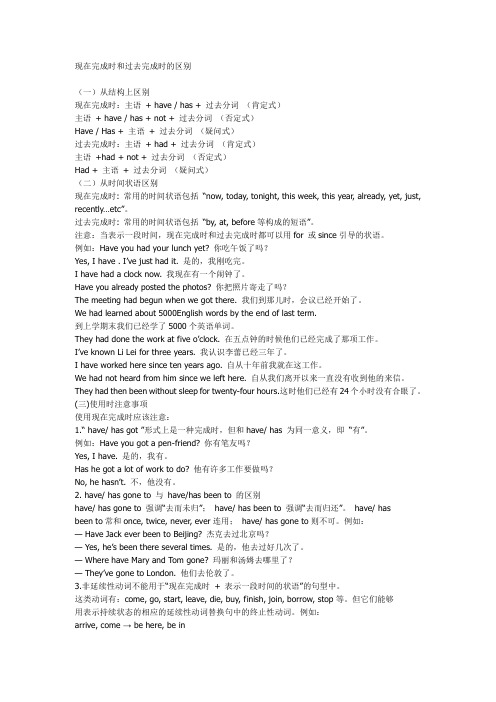
现在完成时和过去完成时的区别(一)从结构上区别现在完成时:主语+ have / has + 过去分词(肯定式)主语+ have / has + not + 过去分词(否定式)Have / Has + 主语+ 过去分词(疑问式)过去完成时:主语+ had + 过去分词(肯定式)主语+had + not + 过去分词(否定式)Had + 主语+ 过去分词(疑问式)(二)从时间状语区别现在完成时: 常用的时间状语包括“now, today, tonight, this week, this year, already, yet, just, recently…etc”。
过去完成时: 常用的时间状语包括“by, at, before等构成的短语”。
注意:当表示一段时间,现在完成时和过去完成时都可以用for 或since引导的状语。
例如:Have you had your lunch yet? 你吃午饭了吗?Yes, I have . I’ve just had it. 是的,我刚吃完。
I have had a clock now. 我现在有一个闹钟了。
Have you already posted the photos? 你把照片寄走了吗?The meeting had begun when we got there. 我们到那儿时,会议已经开始了。
We had learned about 5000English words by the end of last term.到上学期末我们已经学了5000个英语单词。
They had done the work at five o’clock. 在五点钟的时候他们已经完成了那项工作。
I’ve known Li Lei for three years. 我认识李蕾已经三年了。
I have worked here since ten years ago. 自从十年前我就在这工作。
- 1、下载文档前请自行甄别文档内容的完整性,平台不提供额外的编辑、内容补充、找答案等附加服务。
- 2、"仅部分预览"的文档,不可在线预览部分如存在完整性等问题,可反馈申请退款(可完整预览的文档不适用该条件!)。
- 3、如文档侵犯您的权益,请联系客服反馈,我们会尽快为您处理(人工客服工作时间:9:00-18:30)。
典型例题
The students ___ busily when Miss Brown went to get a book she ___ in the office. A. had written, left B. were writing, has left C. had written, had left D. were writing, had left
五、 It was+时间+since+主语+过去完成时。 例如: They asked me to have a drink with them. I said that it was at least ten years since I ______ a good drink. 他们邀请我和他们喝酒,我说,我已经至少 十年没有好好喝过了。 A. had enjoyed B. was enjoying C. enjoyed D. had been enjoying 正确答案为A。
三、 根据上下文的时间关系来确定用过去完成时。例如:
1. The pen I ______ I ______ is on my desk, right under my nose. 那支我以为已经丢了的钢笔。 在我的桌子上,就在我的鼻子底下。 A. think; lost B. thought; had lost C. think; had lost D. thought; have lost
答案为D
典型例题
•
• • • •
Before the first non stop flight made in1949, it ____ necessary for all planes to land for refueling. (CET-4 1996, 6) A) would be B) has been C) had been D) would have been
Summary
一、 主语+过去完成时 +①when引导的从句(注:从句谓语动词为过去式) +②by短语 +③by the time引导的从句(注:从句谓语动词为过去式) +④before引导的从句(注:从句谓语动词为过去式) 例如:
Practice
• 1. Tom was disappointed that most of the guests ______ when he ______ at the party. • A. left; had arrived B. left; arrived • C. had left; had arrived D. had left; arrived 解析: 正确答案为D。guests先“离开”,Tom后 • “到达”。 • 2. We ______ four thousand new words by the end of last year. • A. had learned B. have learned • C. learned D. will have learned • 解析: 根据by短语中的last year得知是到去年年末, • 正确选项为A
二、 1. 主语+had+hardly(scarcely)+过去分词+when(before) +主语+一般过去时。 2.主语+had+no sooner+过去分词+than+主语+一般过 去时。例如: ①They had no sooner got home than it began to rain. 他们一 到家,天就下起雨来。 ②______ got into the room,______ the telephone rang. 他 一到家,电话就响了。 A. He hardly had;then B. Hardly had he;when C. He had not;that D. Not had he;when 解析: 正确答案为B。当否定词hardly,scarcely,no sooner放在句首时,主谓要倒装。
解析: 正确答案为B。“丢笔”是在“认为”之前发生的动作。
四、 表示过去未曾实现的愿望、打算或意图,用过去完成时。 常用动词有:hope,think,expect,intend,mean,suppose, want等。 例如: They had wanted to help but couldn't get here in time. 他们本 来是要来帮忙的,但未能及时赶到。
解析: 正确答案为C。had to wait说明事情发生在过去,而 “忘带钥匙”的动作发生在“等丈夫回家”之前。 3. He _________________his own lab by the time he was ten. 到十岁时, had already built 他已经建起了自己的实验室。 4. He _____________English for five years before he came here. 来这儿 had studied 之前,他已经学过五年英语了。
答案为C
典型例题
•
• • • •
Until then, his family ____from him for six month. ( CET-4 1997, 1) A) didn't hear B) hasn't been hearing C) hasn't heard D) hadn't heard
Present perfect or past perfect?
• The present perfect tense is used when we are talking about a past event which relates to the present time. • Howard Carter is one of the most famous explorers the world has ever known. • The past perfect tense is used when we are discussing the past and want to talk about an even earlier event. • Not long after the tomb had been opened, people in Carter’s team began to fall ill and die strangely.
Practice
2. Helen ______ her keys in the office so she had to wait until her husband ______home. 海伦把钥匙忘在了办公室,所以她不得不 等到丈夫回家。 A. has left; comes B. left; had come C. had left; came D. had left; would come
答案D.
典型例题
• When I arrived at the station, he had already left. We had learned about 4000 English words by the end of last term. I waited until he had finished his homework. We were surprised at what she had done. We ____our breakfast when an old man came to the door. (CET-4 1990,1) • A) just have had B) have just had • C) just had D) had just had.
More examples • He was not worried at all. He ____________ preparations. had already made
Here the past action didn’t happen a long time ago.
• I had done my homeworkwent to the museum.
More examples
• By the end of last year,had I taught _______for 15 years. • When I came back home, my had already finished favourite TV program __________.
